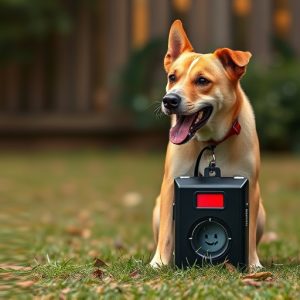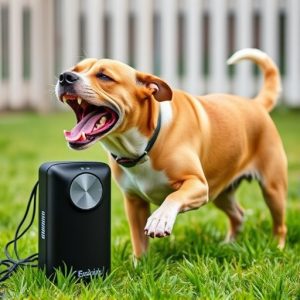Optimize Pet Training: Effective Distance Electronic Dog Deterrents
Electronic pet deterrents offer a modern and safe way to train dogs by using harmless signals to rei…….
Electronic pet deterrents offer a modern and safe way to train dogs by using harmless signals to reinforce boundaries. Choosing the right device requires understanding its effective distance (10-50 feet) and adjusting sensitivity for optimal results without causing harm. Training your dog to accept the deterrent through gradual exposure and positive reinforcement is essential for its success, ensuring it becomes a valuable tool for reinforcing good habits.
Discover the power of electronic pet deterrents, a safe and effective solution for training your furry friends. These devices utilize sound or vibration at adjustable levels to discourage unwanted behaviors, with an optimal effective distance of up to 100 feet. Learn how they work, find the perfect settings for your dog’s temperament, and master the art of training them to accept the device. Say goodbye to problematic pet behavior and embrace a harmonious coexistence.
- Understanding Electronic Pet Deterrents: How They Work
- Choosing the Right Settings for Optimal Effectiveness
- Training and Adjusting Your Dog to the Device
Understanding Electronic Pet Deterrents: How They Work
Electronic pet deterrents are innovative solutions designed to train and discipline pets, especially dogs, using gentle yet effective methods. These devices work by emitting a harmless but unpleasant sound or sensation when a pet approaches a certain boundary, encouraging them to stay within the designated area. The primary mechanism involves setting up a sensor that detects the pet’s presence, triggering an activator that releases a signal. This signal can be in the form of a high-frequency sound, a subtle vibration, or even a mild electric shock, depending on the device and its settings.
The effective distance of these deterrents is a key consideration. Modern electronic dog deterrents are designed to offer precise control, allowing users to set specific boundaries, usually in the form of buried underground wires or wireless sensors. The devices will activate when pets cross these boundaries, ensuring they stay within the desired area without causing harm. This technology is particularly useful for training purposes, helping dogs learn their limits and respect specific zones, whether it’s keeping them in the yard, off the kitchen table, or preventing them from entering neighboring properties.
Choosing the Right Settings for Optimal Effectiveness
When selecting the ideal settings for an electronic pet deterrent, understanding its effective distance is key. These devices emit a safe yet powerful signal within a specific range, typically between 10 to 50 feet (3-15 meters), depending on the model and terrain. For optimal effectiveness, adjust the sensitivity and activation level accordingly; a moderate setting allows for consistent deterrence without causing discomfort or stress to your pet.
Consider factors like the size of your yard, the behavior patterns of your pet, and local environmental conditions. If you have a large property, you might need a device with a longer effective distance. Conversely, in areas with many distractions like trees or bushes, slightly lower settings can be more effective as it ensures the signal doesn’t get masked. Regularly testing and adjusting these settings will help maintain the deterrent’s efficiency over time.
Training and Adjusting Your Dog to the Device
Training your dog to accept and understand an electronic pet deterrent is a crucial step in ensuring its effectiveness. Start by introducing the device at a safe distance, allowing your dog to sniff and become familiar with it without any activation. This helps build positive associations. Gradually increase the effective distance over multiple sessions, rewarding calm behavior as you go. The key is to let your dog adjust at their own pace, ensuring they don’t associate the device with negative experiences.
As you train, be mindful of the sensitivity settings. Adjust them accordingly based on your dog’s reaction and the environment. Remember, the goal is not to shock or scare but to gently guide your pet towards better behavior. Consistent training sessions will teach your dog the boundaries, making the electronic deterrent a valuable tool for reinforcing good habits over time.
An electronic pet deterrent, particularly a dog deterrent, can be an effective solution for managing unwanted behaviors, but its success hinges on proper settings and training. By understanding how these devices operate, selecting the optimal range (up to 1000 feet or more) to match your environment, and consistently training your dog, you can achieve positive results while ensuring safety and comfort. With patience and persistence, an electronic deterrent can help train your furry friend to exhibit desired behaviors, making it a valuable tool for responsible pet ownership.


